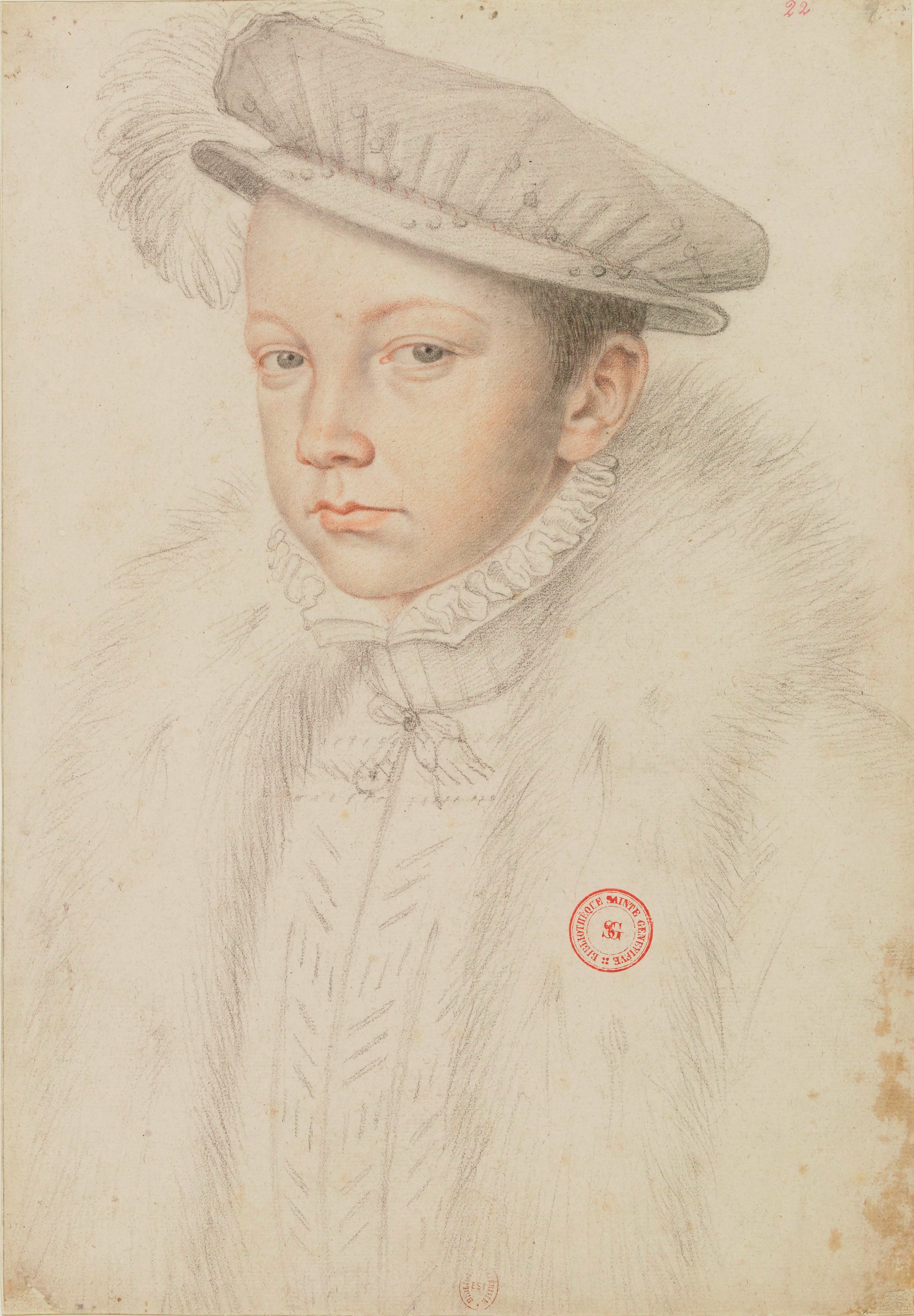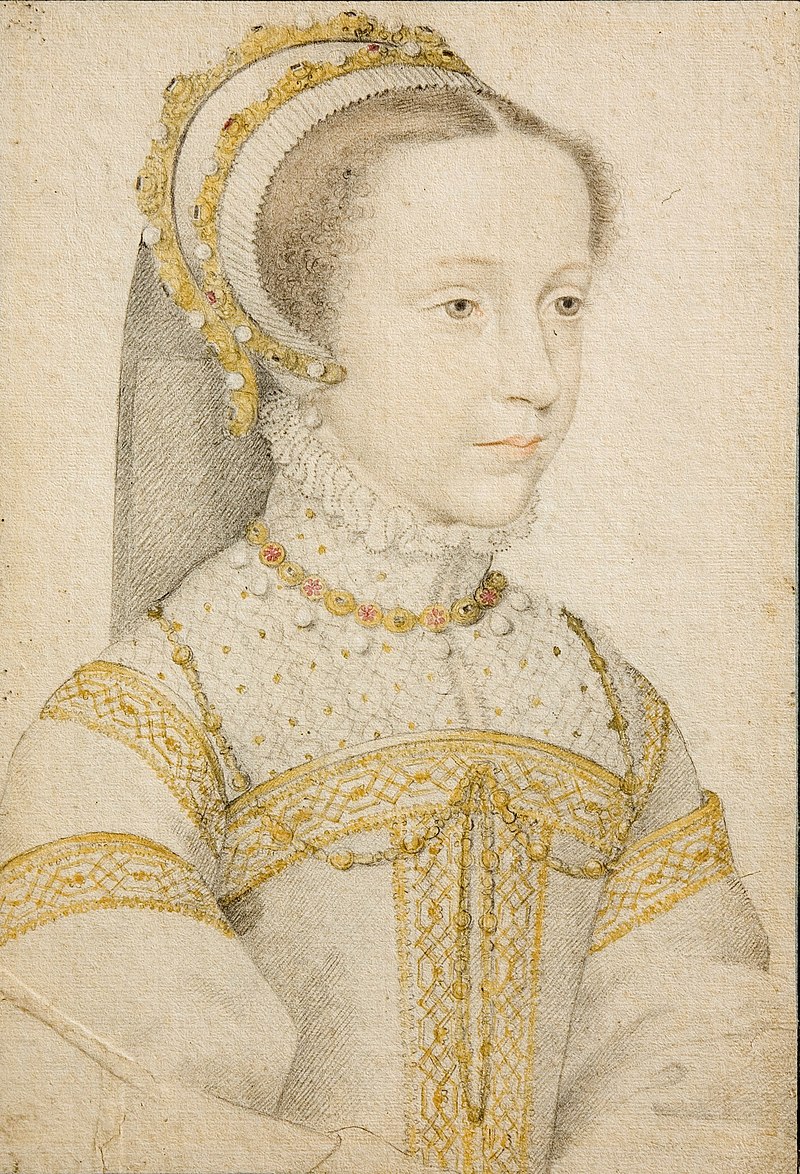by Susan Flantzer © Unofficial Royalty 2017

François II, King of France, King Consort of Scots; Credit – Wikipedia
François II, King of France, the first husband of Mary, Queen of Scots, was born on January 19, 1544, at the Château de Fontainebleau in France. He was the eldest of the ten children of Henri II, King of France and Catherine de’ Medici, daughter of Lorenzo de’ Medici, Duke of Urbino and Madeleine de La Tour d’Auvergne. François was baptized on February 10, 1544, at the Chapelle des Trinitaires in Fontainebleau. His godparents were his paternal grandfather François I, King of France, Pope Paul III, and his great-aunt Marguerite de Navarre. François became heir to the French throne and Dauphin of France in 1547 upon the death of his grandfather François I, King of France. As a child, François suffered from ill health and was considered to be less intelligent and easily distracted. Despite this, François received an education as befitted a prince of that time.
François had nine siblings:
- Elisabeth of Valois, Queen of Spain (1545 – 1568), married King Philip II of Spain, had two daughters
- Claude of Valois, Duchess of Lorraine (1547 – 1575), married Charles III, Duke of Lorraine, had nine children
- Louis, Duke of Orléans (1549 – 1550), died in infancy
- Charles IX, King of France (1550 – 1574), married Elisabeth of Austria, had one daughter who died young
- Henri III, King of France (1551 – 1589), married Louise of Lorraine, no children
- Marguerite of Valois, Queen of France and Navarre (1553 – 1615), married Henri III, King of Navarre, the future Henri IV of France, no children
- Hercule François, Duke of Anjou (1555 – 1584), unmarried
- Victoria of Valois (born and died 1556), twin of Joan, died in infancy
- Joan of Valois, twin of Victoria, died in utero
Across the English Channel in England and in France, events were happening that would result in a marriage for François. James V, King of Scots died in 1542 leaving his six-day-old daughter Mary as Queen of Scots. Mary’s great uncle King Henry VIII of England tried to force an agreement of marriage between Mary and his six-year-old son the future King Edward VI of England to create a new alliance between England and Scotland. Scotland had an alliance with France called the Auld Alliance. When Scotland resisted, Henry VIII declared war resulting in an eight-year war known as the Rough Wooing (1543 – 1551). Because of the English hostilities, Scotland abandoned the possibility of an English marriage. Fearing for Mary’s safety, the Scots appealed to France for help. Henri II, King of France proposed to unite France and Scotland by marrying the young Queen of Scots to his three-year-old son and heir to the French throne François. In July 1548, the Scottish Parliament approved Mary’s marriage to François, Dauphin of France. On August 7, 1548, five-year-old Mary, Queen of Scots set sail for France where she would be raised with her future husband. She would not return to Scotland for thirteen years.

Mary, Queen of Scots, at the age of 12 or 13 by François Clouet, circa 1555–1559; Credit – Wikipedia
On April 24, 1558, 15-year-old Mary married 14-year-old François, Dauphin of France outside Notre-Dame Cathedral in Paris, France. It was a marriage that could have given the future kings of France the throne of Scotland and a claim to the throne of England through Mary’s great-grandfather King Henry VII of England. A little more than a year after the wedding, a great tragedy occurred in France. On June 30, 1559, a great celebration and tournament was held in Paris at the Hôtel des Tournelles (now the site of the Place des Vosges) in honor of the Peace of Cateau-Cambrésis with France’s longtime enemies, the Habsburgs.
King Henri II, at age 40, still liked to participate in tournaments even though he had been advised not to because he suffered dizziness after physical exertion. Henri and Gabriel de Lorges, Comte de Montgomery, captain of the Scotch Guard jousted and Henri had been almost unseated from his horse. He insisted upon a rematch despite the urgings of his wife, the Duke of Savoy, and other friends to stop. The Comte de Montgomery reluctantly agreed to participate. de Montgomery’s lance struck the king’s helmet, splintered, and went through the visor going through the king’s right eye and his temple into the brain.
Henri, bleeding profusely and nearly unconscious, was carried into the Hôtel des Tournelles. Henri survived for more than a week. On July 9, he was given the last rites and he died on July 10, 1559, at the age of 40, probably from a subdural hematoma and sepsis. Henri II’s eldest son succeeded his father as King François II of France. François was crowned at Notre-Dame de Reims in Reims, France in September 1559. However, Mary did not participate in the coronation as she was already an anointed and crowned queen.

King François II of France and his wife Mary, Queen of France and Queen of Scots; circa 1558; Credit – Wikipedia
After only a 17-month reign, François II, King of France, aged 16, died in great pain at the Hotel Groslot d’Orleans in Orléans, France on December 5, 1560, possibly from mastoiditis, meningitis, or otitis which turned into an abscess. François II died childlessly, so his ten-year-old younger brother Charles succeeded him, and his mother Catherine de Médici was named Regent of France. Left a childless widow, Mary decided to return to Scotland, where she married two more times, lost her throne, and was eventually beheaded after being held captive in England for 18 years.
On December 23, 1560, François’ remains were buried at the Basilica of Saint-Denis near Paris, the traditional burial place of French kings. The effigies of many of the kings and queens are still on their tombs, but their bodies were removed during the French Revolution. The remains of the French royalty were removed, dumped into three trenches, and covered with lime to destroy them. In 1817, the restored Bourbons ordered the mass graves to be opened, but only portions of three bodies remained intact. The remaining bones from 158 bodies were collected into an ossuary in the crypt of the church, behind marble plates bearing their names.

Entrance to the crypt where the remains of the French royals were reinterred in 1817, Photo Credit – Susan Flantzer
This article is the intellectual property of Unofficial Royalty and is NOT TO BE COPIED, EDITED, OR POSTED IN ANY FORM ON ANOTHER WEBSITE under any circumstances. It is permissible to use a link that directs to Unofficial Royalty.
France Resources at Unofficial Royalty
Works Cited
- En.wikipedia.org. (2017). Francis II of France. [online] Available at: https://en.wikipedia.org/wiki/Francis_II_of_France [Accessed 20 Jul. 2017].
- En.wikipedia.org. (2017). Henry II of France. [online] Available at: https://en.wikipedia.org/wiki/Henry_II_of_France [Accessed 20 Jul. 2017].
- Unofficial Royalty. (2017). James V, King of Scots. [online] Available at: https://www.unofficialroyalty.com/james-v-king-of-scots/ [Accessed 19 Jul. 2017].
- Unofficial Royalty. (2017). King Henri II of France is mortally wounded in a jousting match. [online] Available at: https://www.unofficialroyalty.com/june-30-daily-featured-royal-date/ [Accessed 20 Jul. 2017].
- Unofficial Royalty. (2017). Mary, Queen of Scots. [online] Available at: https://www.unofficialroyalty.com/mary-queen-of-scots/ [Accessed 20 Jul. 2017].
